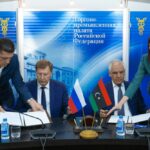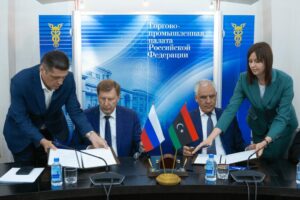Roam, formerly known as Opibus, is a Swedish-Kenyan company founded in 2017 by Filip Lövström and Mikael Gånge, with a mission to implement electric mobility in emerging markets. Initially it began as a research project at one of Sweden’s top technical universities before transforming into an electric mobility company. Roam settled in Kenya given the country’s steady rise as one of sub-Saharan Africa’s fastest-growing nations, especially in relation to electric mobility adoption. Kenya’s growing used-vehicle import market also provides a basis for electric conversions, which was the focus in Roam’s inception years.
Over the years, Roam has evolved to provide tailored solutions to meet market demand through business segments that today include:
- Roam Air, a tailored electric motorcycle for Africa.
- Roam Transit, a segment focused on manufacturing public transport solutions such as electric buses.
- Roam Energy & Charging distributes off-the-shelf energy products.
- Roam Canopy provides tailored software applications to fleet owners, business operators, financiers and others.
Roam’s business model
In 2019, Roam’s market research revealed a lack of reliable, high-quality and environmentally friendly transportation means for African commuters. It established that an affordable transportation alternative to the fossil fuel-powered vehicles can be provided by achieving end-user savings from lower operational and maintenance cost of the motorcycles. With these inputs and extensive product market analysis, Roam decided to design and manufacture its own electric motorcycles locally in Kenya.
Roam is now one of the leading electric motorcycle manufacturers in Kenya with sales exceeding 200 units. Roam’s business model is selling electric motorcycles to asset financiers, energy companies and other enterprises in logistics and transportation. The company sells electric motorcycles at almost price parity with the internal combustion engine (ICE) equivalent. By selling electric motorcycles on an upfront cash basis to businesses, Roam passes on the asset financing requirement and where possible, operating the charging infrastructure to its network partners. Most recently, Roam partnered with M-Kopa, an African asset financing platform, signing a supply agreement that will see mass deployment of electric motorcycles financed through the M-Kopa platform using a pay-as-you-go model.
Roam is also partnering with mini-grid companies that can finance and provide charging infrastructure to acquire rural customers. This is an attractive proposition for mini-grid developers as electric mobility could potentially increase demand at their sites, acting as anchor clients. Consequently, Roam has partnered with Powerhive, a mini-grid developer with existing sites in Kenya.
Local manufacturing and assembly
According to Roam, manufacturing and local assembly is key to reducing the final price of electric motorcycles while also allowing for product customisation to meet local market needs. In addition, Roam’s ambition is to build all the hardware and software infrastructure which other key players in the industry can utilise. This is comparable with Gogoro’s “hardware as a service” model. In this model, they sell underlying hardware such as bike components and kit parts to original equipment manufacturers (OEMs) which greatly increases interoperability within the battery-swapping network.
Roam currently has the capacity to design 100% and manufacture 35% of its electric motorcycle in-house. It has an ambitious goal to manufacture and assemble as much as 70% of the motorcycle locally over the next three to five years. Its next-generation electric motorcycles will even include proprietary frames, a first of its kind in Africa.
Roam has prioritised components where local manufacturing capacity already exists, e.g. injection moulding, welding, metal bending and sub-assemblies. Roam is collaborating with 10 local suppliers that currently manufacture ICE motorcycle parts to help them transition to electric motorcycle manufacturing. Since some components such as battery cells and base components (resistors and converters) require high production standards and capital expenditure to set up locally, these will still have to be procured internationally.
Besides scaling locally, Roam has plans to expand beyond Kenya to other African markets through strategic partnerships. One such partnership is to supply Uber with 3,000 electric bikes for its delivery services. Through this partnership, Roam will strategically position itself to scale across Uber’s geographical reach, including Ghana, Nigeria, Côte d’Ivoire, Tanzania, Uganda and South Africa.
Growth challenges
One of the most recent challenges has been faulty batteries, which led to a delay in the delivery of electric motorcycles. The batteries were depleted on arrival and inspection revealed that the internal wiring did not meet specifications. For safety purposes, the batteries had to be returned to China for redesign and testing before they could be used locally for the bikes. An in-depth quality control framework will be implemented in China to mitigate the above-mentioned risks, ensuring reliable batteries of high quality.
Scaling an electric motorcycle manufacturing business can be costly due to the large CAPEX needed to set up manufacturing infrastructure and the working capital to build inventory. The sale of EVs and maintenance of supporting infrastructure require substantial investments. Roam is looking to raise US$17.5 million in equity and debt for working capital as part of its Series A funding round to reach its 2024 operational targets.
From Roam’s experience, there is a lack of local labour and specialist experience in the electric mobility sector. There is a need to upskill the existing workforce of engineers and technicians to meet the future demands of the sector, e.g. in design, manufacturing, operations and maintenance.
To increase its own capacity, Roam staff receive on-the-job training and, in some instances, experienced specialists are brought in for specific assignments to bridge the skills gap.
Source : Howwemadeitinafrica















